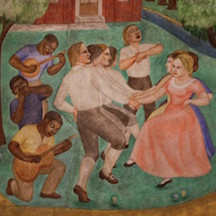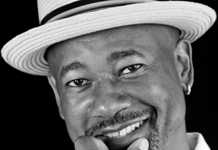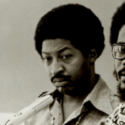 During the Great Depression, Ann Rice O’Hanlon painted a 38 feet wide, 11 feet tall mural on Kentucky history in the University of Kentucky’s Memorial Hall. The mural depicted enslaved African Americans hunched in a field, Black musicians playing for White dancers, and a Native American threatening a White settler with a tomahawk. In 2015, the university draped sheets over the mural. In 2018 a new art installation in the hall, meant to counteract what many regarded as offensive images from Kentucky’s past, was placed on the ceiling of the hall where the mural was once again displayed.
During the Great Depression, Ann Rice O’Hanlon painted a 38 feet wide, 11 feet tall mural on Kentucky history in the University of Kentucky’s Memorial Hall. The mural depicted enslaved African Americans hunched in a field, Black musicians playing for White dancers, and a Native American threatening a White settler with a tomahawk. In 2015, the university draped sheets over the mural. In 2018 a new art installation in the hall, meant to counteract what many regarded as offensive images from Kentucky’s past, was placed on the ceiling of the hall where the mural was once again displayed.
In 2020, amidst the nationwide protests in the aftermath of George Floyd’s murder, Eli Capilouto, president of the University of Kentucky issued a statement that read in part: “We have discussed the mural for many years and made a number of important, productive efforts to seek common ground and lasting solutions. But the spaces we have created for dialogue, and the work we have commissioned to expand conversation and contextualize art, haven’t worked. Our efforts and solutions with the mural, for many of our students, have been a roadblock to reconciliation, rather than a path toward healing. I am directing our facilities team to immediately begin the process of removing the mural in Memorial Hall.”
That led to a lawsuit filed by Kentucky author Wendell Berry filed against the university. According to the lawsuit, the mural is a publicly-owned piece of art that promotes education, and it would be unsafe to remove.
Now the university has set aside funds to renovate Memorial Hall. This renovation will include the removal of the mural, which may be moved to a museum or other facility, pending the outcome of the lawsuit.
President Capilouto noted that “for many, Memorial Hall is an iconic building in the heart of our campus. For many others, it is a space where a mural, in place since the 1930s, depicts in a distorted fashion the way enslaved people and other marginalized peoples were treated in Kentucky.”











